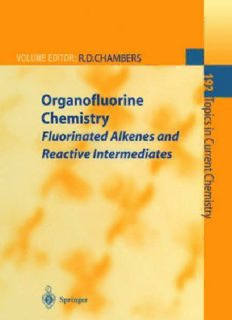
Organofluorine Chemistry: Fluorinated Alkenes and Reactive Intermediates PDF
Preview Organofluorine Chemistry: Fluorinated Alkenes and Reactive Intermediates
192 Topics in Current Chemistry EditorialBoard: A.deMeijere· K.N.Honk·J.-M.Lehn·S.V.Ley J.Thiem·B.M.Trost·F.Vogtle·H.Yamamoto Springer Berlin Heidelberg NewYork Barcelona Budapest HongKong London Milan Paris Santa Clara Singapore Tokyo Organofluorine Chemistry Fluorinated Alkenes and Reactive Intermediates Volume Editor: R.D. Chambers With contributions by B.Ameduri)V.V.Bardin)B.Boutevin) R.D. Chambers)W.R.Dolbier)Jr.) u. A. Petrov)J.F.S.Vaughan Springer This seriespresentscriticalreviews ofthepresentpositionandfuture trendsin modernchemicalresearch.Itisaddressedtoallresearchandindustrialchemists whowishtokeepabreastofadvancesinthetopicscovered. Asarule)contributionsarespeciallycommissioned.Theeditorsandpublisherswill) however)alwaysbepleasedtoreceivesuggestionsandsupplementaryinformation. Papersareacceptedfor"TopicsinCurrentChemistry))inEnglish. InreferencesTopicsinCurrentChemistryisabbreviatedTop.CurroChern.andis citedasajournal. SpringerWWWhomepage:http://www.springer.de VisittheTCChomepageathttp://www.springer.de/ ISSN0340-1022 ISBN3-540-63171-2 Springer-VerlagBerlinHeidelbergNewYork LibraryofCongressCatalogCardNumber74-644622 Thisworkissubjecttocopyright.Allrightsarereserved)whetherthewholeorpart ofthematerialisconcerned)specificallytherightsoftranslation)reprinting)reuse ofillustrations)recitation)broadcasting)reproductiononmicrofilmsorinanyother ways)andstorageindatabanks.Duplicationofthispublicationorpartsthereofis onlypermittedundertheprovisionsoftheGermanCopyrightLawofSeptember9) 1965)initscurrentversion)andpermissionforusemustalwaysbeobtainedfrom Springer-Verlag.ViolationsareliableforprosecutionundertheGermanCopyright Law. ©Springer-Verlag BerlinHeidelberg1997 PrintedinGermany The use ofgeneral descriptive names)registered names)trademarks)etc.in this publicationdoesnotimply)evenintheabsenceofaspecificstatement)thatsuch namesareexemptfromtherelevantprotectivelawsandregulationsandtherefore freeforgeneraluse. Coverdesign:FriedheImSteinen-Broo)Barcelona Typesetting:Fotosatz-ServiceKohlerOHG)97084Wiirzburg SPIN:10556003 66/3020-543210-Printedonacid-freepaper Volume Editor Prof.Richard D.Chambers,F.R.S. DepartmentofChemistry UniversityofDurham SouthRoad DH13LEDurham,GreatBritain E-mail:[email protected] Editorial Board Prof.Dr.ArmindeMeijere Prof.K.N.Houk InstitutfurOrganischeChemie DepartmentofChemistryandBiochemistry derGeorg-August-UniversiHit UniversityofCalifornia TammannstraBe2 405HigardAvenue D-37077Gottingen,Germany LosAngeles,CA90024-1589,USA E-mail:[email protected] E-mail:[email protected] Prof.Jean-MarieLehn Prof.StevenV.Ley InstitutdeChimie UniversityChemicalLaboratory UniversitedeStrasbourg LensfieldRoad 1rueBlaisePascal,B.P.Z296/R8 CB2 lEWCambridge,GreatBritain F-67008StrasbourgCedex,France E-mail:[email protected] E-mail:[email protected] Prof.Dr.JoachimThiem Prof.BarryM.Trost InstitutfurOrganischeChemie DepartmentofChemistry UniversiHitHamburg StanfordUniversity Martin-Luther-King-Platz6 Stanford,CA94305-5080,USA D-20146Hamburg,Germany E-mail:[email protected] E-mail:[email protected] Prof.Dr.FritzVogtle Prof.HisashiYamamoto InstitutfurOrganischeChemie SchoolofEngineering undBiochemiederUniversitat NagoyaUniversity Gerhard-Domagk-StraBe1 464-01 Chikusa,Nagoya,Japan D-53121 Bonn,Germany E-mail:[email protected] E-mail:[email protected] ecaferP Fluorine is unique, in that it is possible to replace hydrogen in an organic mole- cule by fluorine either singly or multiply and, in so-doing, create a potentially infinite extension to organic chemistry that is entirely synthetic. The excitement of the chemistry of these systems stems from the unique reactions that ensue and the 'special-effects' that introduction of fluorine impart. Indeed, these effects are now exploited in a remarkable array of applications across the whole of the chemical, pharmaceutical, and plant-protection industries, although this is not widely appreciated. In this book, we have gathered authors with immense experience in various aspects of their field and each is a world-authority on the important topics they have described. Some topics, like the use of elemental fluorine, and enzymes in synthesis, are relatively new areas that are rapidly growing. eW dedicate the book to a long standing friend, Professor George Olah, in the year of his 70th birthday, in recognition of his massive achievements. Durham, May 1997 Dick Chambers Contents NucleophilicReactionsofFluorinatedAlkenes R.D.ChambersandJ.F.S.Vaughan . ReactionsofElectrophileswithPolyfluorinatedOlefins U.A.PetrovandV.V. Bardin . . . . . . . . . . . . . . . . 39 FluorinatedFreeRadicals W.R.Dolbier,Jr. . . . . . . 97 TelomerisationReactionsofFluorinatedAlkenes B.AmeduriandB.Boutevin .. 165 AuthorIndexVolumes151-192 235 Contents ofVolume 193 OrganofluorineChemistry:Techniques and Synthous VolumeEditor:R.D.Chambers ElementalFluorineinOrganicChemistry J.HutchinsonandG.Sandford FluorinatedOrganometallicCompounds D.V.Burtonand1.Lu EnzymaticallyControlledReactions ofOrganofluorineCompounds T.KitazumeandT.Yamazaki BuildingBlockApproachestoAliphatic OrganofluorineCompounds J.M.Percy ElectrofluorinationofOrganicCompounds F.G.Drakesmith Nucleophilic Reactions of Fluorinated seneklA R. D. Chambers and . F. S. Vaughan Department of Chemistry, University of Durham, South Road, Durham, DH1 3LE, U.K. E-mail: r.d.chambers @ durham, ac. uk Fluorinated -alkenes and -cycloalkenes have a special relationship with their hydrocarbon analogues, usually exhibiting a chemistry that is complementary. For example, the fluorinated systems are frequently susceptible to nucleophilic attack, in some cases dramatically so, and therefore reactions of nucleophiles with fluorinated alkenes often reveal unique new chem- istry. This chapter covers electrochemical reduction, principles governing orientation and reactivity of fluorinated alkenes towards nucleophiles, fluoride ion as a nucleophile and the 'mirror-image' relationship of this chemistry with that of proton-induced reactions, reactions with nitrogen-, oxygen-, carbon- centred nucleophiles etc., and, finally, chemistry of some oligomers of fluorinated -alkenes and -cycloalkenes. :sdrowyeK Fluorinated alkenes; nucleophilic attack; fluoride ion; oligomerisation; rearrange- ments; displacement; carbanions. 1 Introduction ................................ 2 2 Substituent Effects of Fluorine and Perfluoroalkyl Groups ...... 3 3 Electrochemistry and Related Electron-Transfer Processes ..... 4 4 Reactivity and Regiochemistry of Nucleophilic Attack ........ 9 5 Reactions Involving Fluoride Ion .................... 11 5.1 Additions ................................. 13 5.2 Nucleophilic Analogues of Friedel Crafts Reactions .......... 13 5.3 Oligomerisation .............................. 14 5.4 Rearrangements .............................. 16 6 Attack by O, S and N Centred Nucleophiles ............... 18 7 Carbon Nucleophiles ........................... 24 8 Hydride Reductions ............................ 26 9 Reactions of Oligomers .......................... 27 References . . . . . . . . . . . . . . . . . . . . (cid:12)9 ~ . . . . * . . . . . (cid:12)9 ~ (cid:12)9 (cid:12)9 35 scipoT in Current Chemistry, .loV 291 (cid:14)9 Springer galreV Berlin Heidelberg 7991
Description: